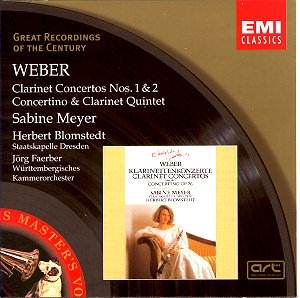Weber is the living refutation of the idea that
German composers have to be serious-minded and logical. It is
true that he is always ready with an expressive turn of phrase,
amounting to real depth and poetry in slow movements, particularly
that of the Quintet, possibly the finest work here. But he is
also ready to break into cheeky humour – again the Quintet provides
the supreme example with its "Capriccio presto" Minuet
– and into virtuoso flights that exist purely for entertainment.
So much for Germanic seriousness, but he is no less of a free
spirit in his way of constructing a piece, always ready to dart
off at a tangent or to halt the proceedings because now it’s time
for some grand pathos or a dramatic gesture.
These particular works were inspired by the playing
of Heinrich Bärmann, whose triumphant first performance of
the Concertino in April 1811 led to the commission by the King
of Bavaria to write two concertos for Bärmann, both of which
were ready by July of the same year. The Quintet took a little
longer and is not to be considered a chamber work in the sense
of a piece for five equal partners, but a concerto for clarinet
with string quartet accompaniment. It loses nothing in the present
transcription and maybe gains something, especially when Faerber
is a snappier conductor than Blomstedt.
Sabine Meyer achieved notoriety following Herbert
von Karajan’s insistence on taking her into the Berlin Philharmonic
against the orchestra’s wishes (they felt she was a fine soloist
but not a good orchestral player). Her prowess as an orchestral
player is not on trial here; the important thing is that she proves
an ideal soloist, entering into Weber’s quicksilver changes of
mood, now poetic and musing, now sparkling and hugely virtuosic,
now powerfully dramatic. She has a wide range of tone and expression,
and total control over her instrument.
Due perhaps to the resonant Dresden acoustic,
Blomstedt does not always convince me that Weber’s imaginative
use of the solo wind instruments was equally matched by his command
of the full orchestra, which sometimes sounds muddy-textured and
unclear. But still, the reflectors are on Meyer and she never
lets go of you.
Christopher Howell
Great
Recordings of the Century
